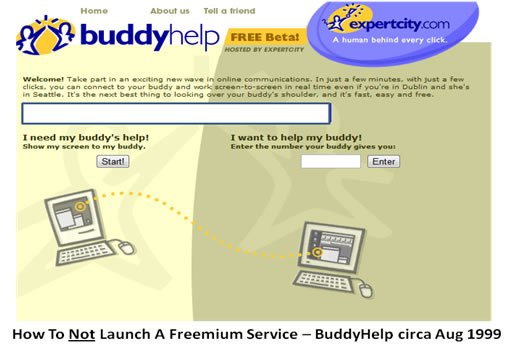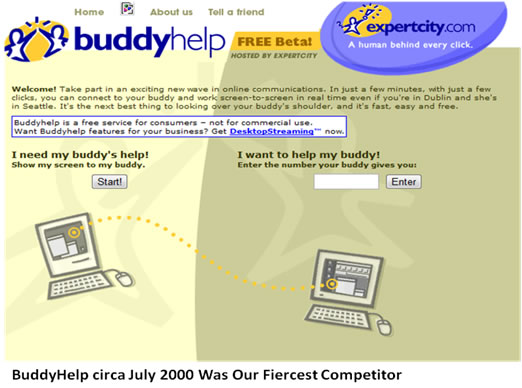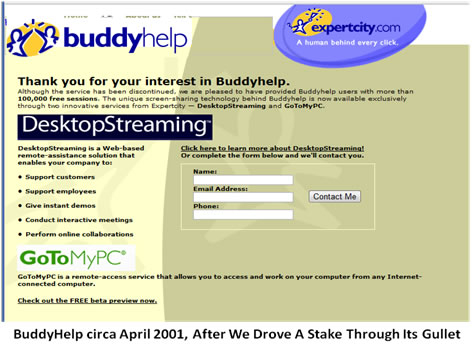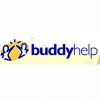 In the summer of 1999, Expertcity (creator of GoToMyPC and GoToMeeting, acquired by Citrix) released a free service called BuddyHelp. In the spirit of the “land grab” mentality of the day, we emphasized usage of our screen sharing technology with no thought applied to how we would convert such users into paying customers.
In the summer of 1999, Expertcity (creator of GoToMyPC and GoToMeeting, acquired by Citrix) released a free service called BuddyHelp. In the spirit of the “land grab” mentality of the day, we emphasized usage of our screen sharing technology with no thought applied to how we would convert such users into paying customers.
If you haven't already subscribed yet, subscribe now for
free weekly Infochachkie articles!
The Internet Should Be Free
In addition to the “eyeballs at all cost” mindset of 1999, there remained a very strong feeling within a subset of the tech community that, “The Internet Should Be Free.” Other than the access fees charged by Internet Service Providers, the era of paid Internet services was nascent.
BuddyHelp was launched in this proto-Internet environment and was immediately used by businesses to provide hands-on technical support. At companies such as SaskTel, Gateway and Cablevision, customer support agents used BuddyHelp to access their customers’ computers and handle their technical support issues.
As shown in the screenshot below, the initial launch of BuddyHelp did not restrict commercial usage. Anyone, including well-healed, Big Dumb Companies, could offer state-of-the-art technical support for free. Wonderful… except we were stuck paying the bandwidth charges, purchasing servers to handle the growing load of users (in those pre-Cloud days) and fielding support questions – all from a group of users that generated not a single dime of revenue.

As noted in B-side Entrepreneurial Hits, Expertcity’s initial business plan of allowing independent experts to utilize our technology for the purposes of providing technical support proved to be a great business model for raising money ($34 million at a pre-money valuation of $80 million with zero revenue), but a lousy business model for making money.
Thus, we became one of the first ASP (aka SaaS) companies, by selling subscriptions of our screen sharing technology to customer service departments – the same market segment which had adopted BuddyHelp. One would assume that once we began licensing our technology, we immediately shut down BuddyHelp and effectively forced the freeloaders to pay for our commercial offering. Unfortunately, there was a contingent within Expertcity, which believed that BuddyHelp should remain a free service, even after we launched DesktopStreaming (the genesis of DesktopStreaming’s terrible name is described in, Lousy Products Might Break Your Bones – But A Name Will Seldom Hurt You).
In order to jumpstart our DesktopStreaming licensing efforts, it became imperative that since we intended to continue offering BuddyHelp at no charge (which was not my preference), we had to transform the free service into a source of qualified DesktopStreaming leads.
The first step was to identify who was using the service. As we did not require users to sign in, we were forced to correlate IP addresses with company names, which, in 1999, was an inexact and very manual science. Once we located a company that we suspected was using BuddyHelp for commercial purposes, we then sent emails to any senior executive we could identify (using the techniques described in Infiltrating Big Dumb Companies), hoping to eventually contact someone in the customer support department. Not surprisingly, our success rate was abysmal.
After some healthy wrangling with the “The BuddyHelp Should Be Free” folks, we eventually made a slight modification to the site, as shown below.

We still allowed anyone to use the service but we added text indicating that BuddyHelp was a consumer product in the hopes of making corporate users feel slightly guilty about ripping us off. This change did cause a handful of companies to contact us and license our commercial solution. Unfortunately, most of the freeloading entities continued to use the service and ignored our plaintive emails, which simultaneously encouraged them to license DesktopStreaming while threatening them with potential legal action if they did not stop using BuddyHelp commercially.
After more cajoling, those of us interested in generating revenue convinced the “BuddyHelp Should (Still) Be Free” contingent to place an email address field in the page flow. Even though this field was not required to use the service, many users assumed that it was a prerequisite for use and provided us with a surprising number of valid email addresses. We then sorted these email addresses by company and initiated targeted sales campaigns wherever we identified a critical mass of users.
For instance, if we identified a group of users from IBM, we contacted them as a group, and notified them as to which of their peers were also using BuddyHelp. We then asked them to encourage IBM to license DesktopStreaming on their behalf. Although this approach was imperfect, it allowed us to leverage BuddyHelp as an inelegant source of qualified DesktopStreaming leads. In the course of a few months, despite the cumbersome sales cycle, we finalized deals with a number of former BuddyHelp users including CompUSA, Blackbaud and Cox.
With the release of GoToMyPC in January 2001, we finally drove a stake through BuddyHelp. Not surprisingly, we received a litany of hate email from freeloaders admonishing us for taking away their free service. Shame on us for allowing people to believe BuddyHelp was an entitlement we were obligated to provide for free and in perpetuity. In its final days, the site continued to drive substantial traffic from would-be freeloaders, which we leveraged by displaying advertisements for DesktopStreaming (now known as GoToAssist) and GoToMyPC.

Ways To Make A Freemium Service Work
The concept of a Freemium solution was not well founded when we launched BuddyHelp. Precursors certainly existed, including games such as Doom, which allowed players to access the first few gaming levels at no charge. The Freemium approach is now widely recognized as an effective product rollout strategy in which one version of the solution is offered at no charge, while other versions of the product require payment. However, in 1999, the free-to-paid rules were still largely unwritten.
Just because we did a dismal job of turning BuddyHelp into a revenue-generating asset, does not mean that it was impossible. Experience is what you get when you do not get what you want and we got a whole lot of experience from BuddyHelp. In fact, the lessons we learned allowed us to effectively convert the majority of our 50,000 free GoToMyPC Beta users into paying customers.
With the advantage of hindsight, listed below are a number of actions we should have taken to convert BuddyHelp from a channel conflict nightmare into a lead generating machine.
Clear Communications – The primary reason we caused our BuddyHelp users so much angst is because they perceived that we changed the rules in the middle of the game, which, in fact, we did. GoToMyPC was a successful free Beta because we made it clear from the outset that it would only be free for a limited time. Thus, when we flipped the switch to a paid service, no one was surprised. We failed to apprise our BuddyHelp users of our plans to charge for the use of our technology, thereby eliciting their wrath and feelings of betrayal.
Logical Upsell Plan – We were forced to change the rules on our BuddyHelp users because we launched the service without a strategic plan. We literally said, “Let’s put it out there and see what happens.” What happened should not have been a surprise. We gave away a valuable service and our users revolted when we tried to force them to pay for it. Avoid this mistake by crafting a logical plan by which users are charged for the service, either after a trial period or in exchange for other benefits, such as no advertisements, more features, extended use privileges, etc.
Consistent Rules– Freemium services result in satisfied users who have a higher propensity to pay when they feel that the rules are clear and consistent. Most users are ethical and willing to pay once they begin using the product in a manner which they know qualifies as “commercial use.”
Make Cheaters Work – Resign yourself to the reality that some users will pride themselves on cheating. These users will sign up for multiple free trials with a variety of email addresses and user names simply to avoid payment. Such unscrupulous users will never pay. Thus, it is not worthwhile to erect barriers to impede committed cheaters as such constraints will undoubtedly cause friction for honest users. Hold your nose and make it difficult, but not impossible, for such nefarious users to freeload.
Prop Up Your Value – A convenient and effective way to segment Freemium users is to denude the value prop of the free service. However, as noted in MVP², care should be taken to not reduce your value prop so much that your free offering besmirches your overall brand. A worthless / worth-little free product will be an ineffectual lead generation tool.
There are a variety of ways to reduce the utility of a free service, such as:
- Limited usage - Dropbox offers 2GBs of storage free and eFax allows users to send 30-pages free each month.
- Limited features - LogMeIn offers remote access for free, but charges for additional features.
- Market segment - Give .edu and .org users free access, but make users with a .com email address pay
RightScale combines the last two approaches by conscribing its free product’s use to individuals and limiting its functionality
Making Free Users Pay
The most common method of transforming free customers into paying customers is by offering a free trial for a limited time period. If you decide to offer a free version of your solution and elect to not utilize a trial period as a means of spurring paid usage, seek non-intrusive ways to monetize free users, at least to the extent that you negate the costs associated with delivering the service. There are a variety of ways in which you can generate income from otherwise free users, including:
Lead Gen – As we learned once we began to effectively harvest BuddyHelp users, free users can be an inexpensive source of paying customers. Such users have self-selected your solution, are familiar with its value proposition and (hopefully) have received utility from your free offering. As such, the sales cycle can be compressed by calling upon such pre-qualified users.
To effectively execute this strategy, ensure that you obtain sufficient information before users can access your freebies, similar to the email field we put into BuddyHelp’s screen flow.
Advertising – Companies such as, eFax and YouSendIt generate significant revenue by presenting relevant ads to their respective free users. However, this model requires large numbers of users to generate meaningful revenue.
Co-Registration – When users sign up to your free service, offer them complimentary services from a select group of partners. You can generally negotiate meaningful cost per acquisition rates for such co-registered users. Such revenue can offset some of the costs generated by free users.
No Help From BuddyHelp
Properly launched, BuddyHelp could have been an effective Freemium lead generation source for Citrix. However, because of the BuddyHelp Should Be Free vestige that underlied much of our 1999 thinking, we angered and frustrated most of the BuddyHelp community with our inconsistent messaging and lack of a thoughtful plan. Despite our repeated blundering, BuddyHelp did generate some substantial commercial customers. However, a proactive coordinated approach would certainly have led to fewer frustrated customers, more qualified leads and less internal discord.





Pingback: Interview: Jason Nazar of Docstoc
Pingback: Interview: Arnie Gullov-Singh, CEO of Ad.ly
Pingback: Interview: Benjamin Satterfield, Co-Founder & CEO TestFlight
Pingback: Jason Alba (al - buh)» Blog Archive » Freemium Models: Must Read
Pingback: 6 Steps To Raising Venture Capital — Hint: Preparation Matters More Than Your Pitch | Pham Capital
Pingback: 6 Steps To Raising Venture Capital – Hint: Preparation Matters More Than Your Pitch